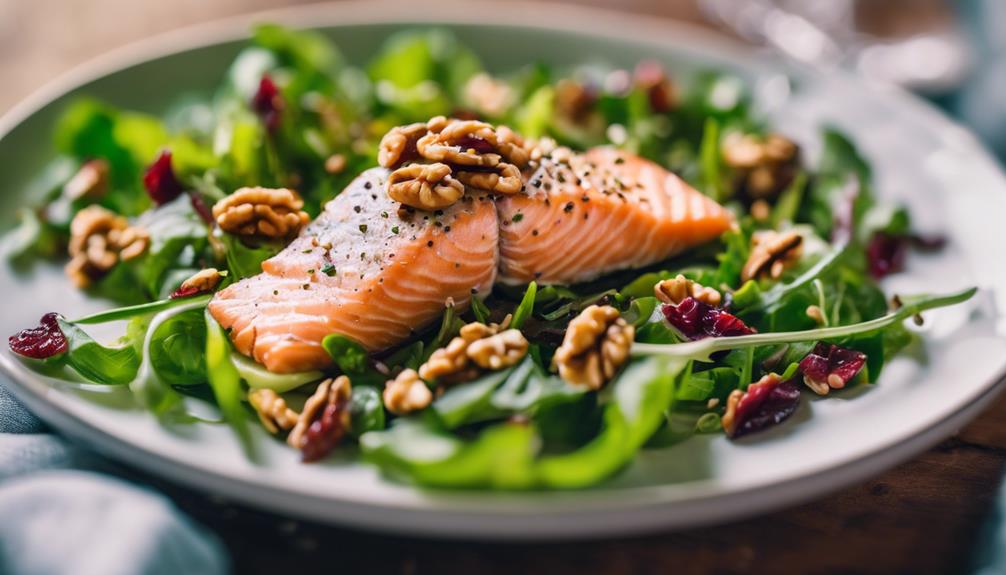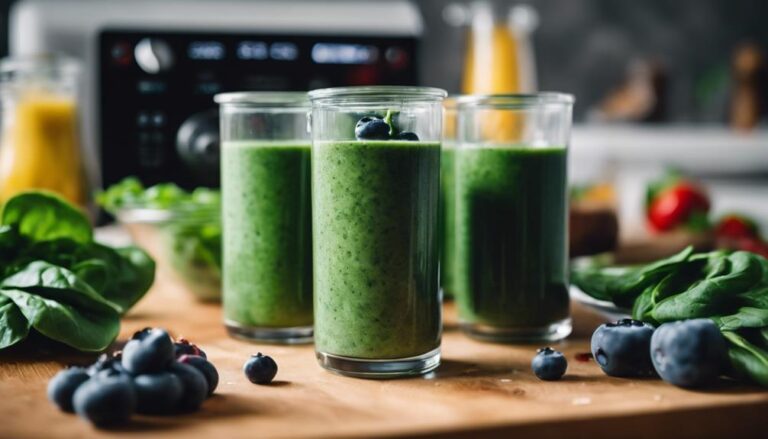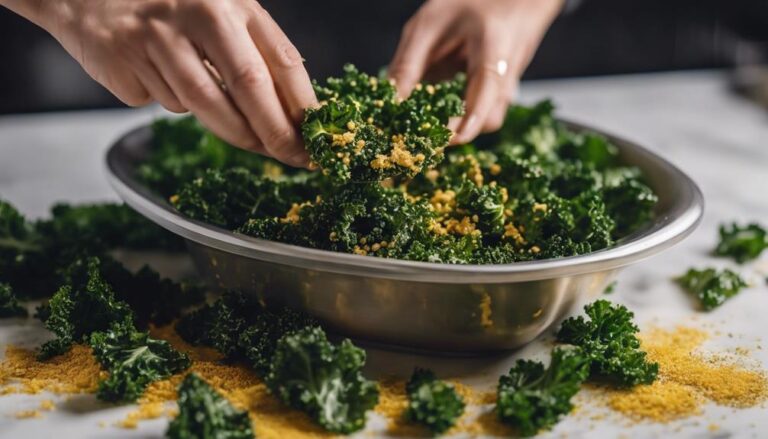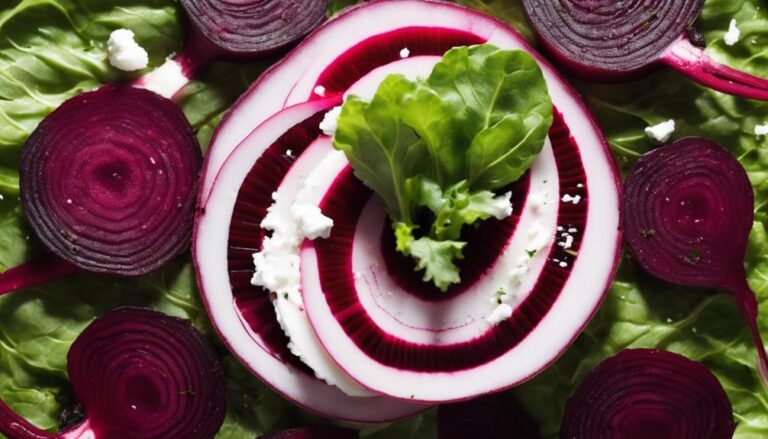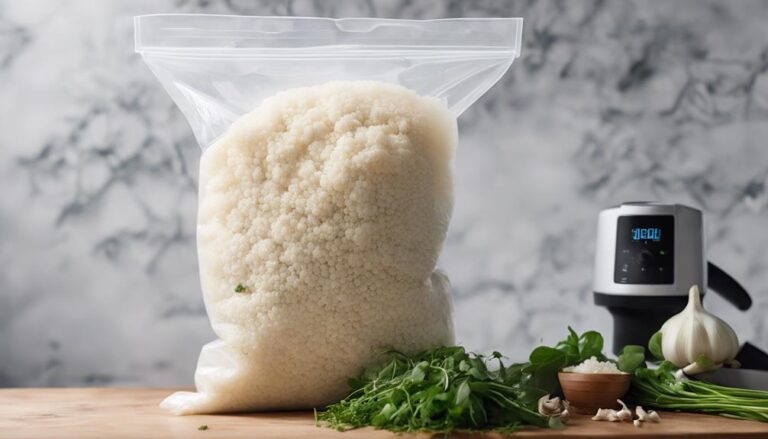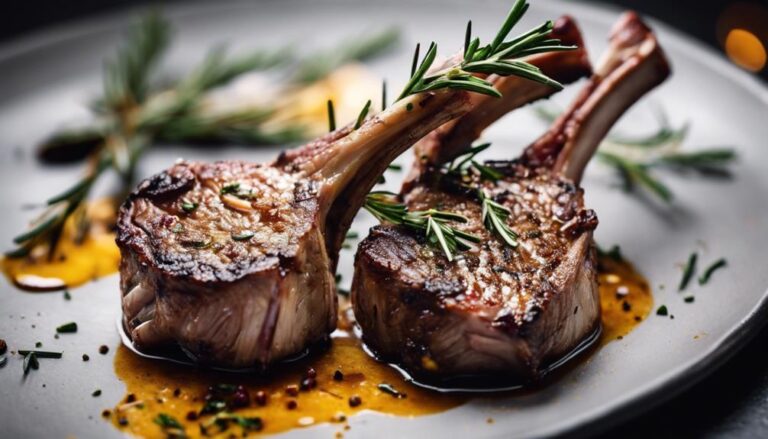Mixed Greens Salad With Sous Vide Salmon and Walnuts
Savor the perfect balance of flavors and textures in a mixed greens salad, paired with tender sous vide salmon and crispy walnuts. The salmon, cooked precisely for best tenderness, complements the nuttiness of walnuts and the freshness of mixed greens. The sous vide method guarantees a moist and delicate taste, enhancing your dining experience. Each ingredient offers nutritional benefits for a well-rounded meal. Explore the delicious harmony of ingredients in this dish and discover a symphony of taste and health benefits waiting for you!
What You Will Learn Here
- Sous vide cooking preserves salmon's moisture and delicate flavor.
- Walnuts add a crunchy texture and nutty essence to the dish.
- Mixed greens salad provides essential nutrients and antioxidants.
- Combination of ingredients offers a balance of flavors and nutrients.
- Sous vide salmon delivers omega-3 fatty acids for heart and brain health.
Salmon's Journey Through Time
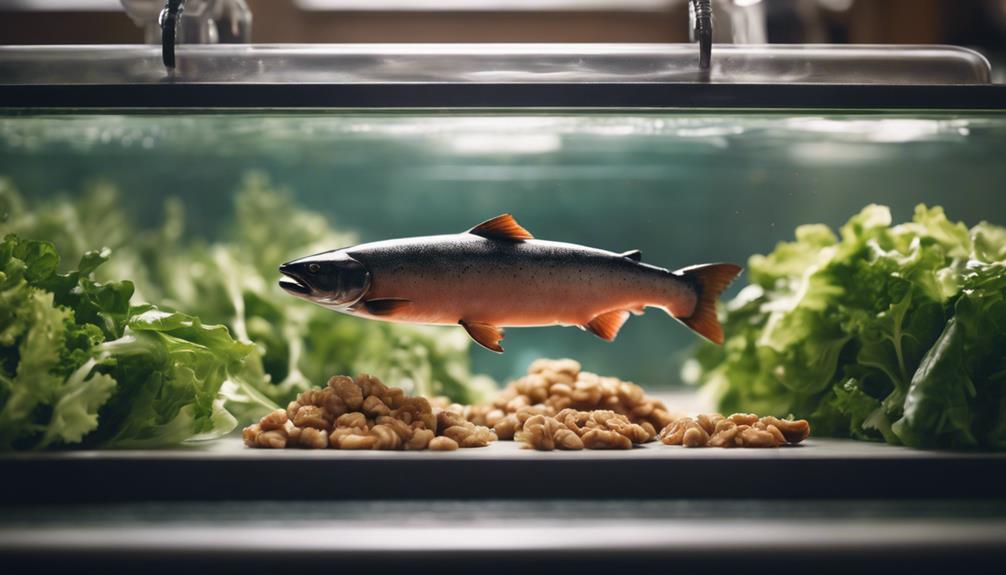
Imagine the ancient civilizations that revered the mighty salmon, a fish that has swum through the annals of time.
From the earliest records of human history, salmon has been a prized catch, sustaining communities and cultures.
As you explore the historical significance of salmon, you uncover a deep connection between humanity and this resilient fish.
Evolution of Salmon
Millions of years ago, salmon emerged as resilient creatures that have since undergone remarkable evolutionary adaptations to thrive in diverse aquatic environments. Their evolution reflects a journey of resilience and adaptability, shaping them into the iconic species we recognize today.
Salmon have honed their ability to navigate challenging habitats, moving from freshwater rivers to the vast expanses of the open ocean. This evolution has equipped them with the skills needed to undertake epic migrations for spawning, with some species traveling hundreds of miles against strong currents.
However, human activities such as habitat destruction and overfishing have posed significant threats to their existence. Conservation efforts, including habitat restoration and sustainable fishing practices, are essential in safeguarding the future of these remarkable creatures.
Historical Salmon Facts
Through centuries of human history, salmon has been a foundational pillar of sustenance, commerce, and cultural significance. Indigenous peoples have relied on salmon as a crucial food source for thousands of years, honoring its place in their traditions and diets. This prized fish hasn't only sustained communities but also shaped economies and cultures worldwide.
From the Pacific Northwest to Scandinavia, salmon has been at the center of trade and culinary practices, symbolizing abundance and nourishment. However, the exploitation of salmon through commercial fishing has raised concerns about declining populations and habitat destruction, prompting conservation efforts to safeguard this iconic species. By studying salmon migration patterns and life cycles, scientists aim to secure the preservation of these majestic creatures for generations to come.
Salmon in Ancient Times
Salmon's enduring presence as an essential food source and cultural symbol among ancient civilizations along the Pacific Northwest coast underscores its profound significance in shaping both dietary practices and societal values throughout history.
Indigenous peoples, such as the Chinook, Nez Perce, and Salish tribes, revered salmon for its role in sustaining their communities both physically and spiritually. These ancient societies relied on the annual salmon runs not only for nourishment but also as a symbol of abundance and prosperity.
The cyclical nature of salmon runs was celebrated as a reminder of the interconnectedness between humans and nature, highlighting the deep respect and gratitude these indigenous peoples held for the salmon that enriched their lives in numerous ways.
Salmon Seasoning Variations
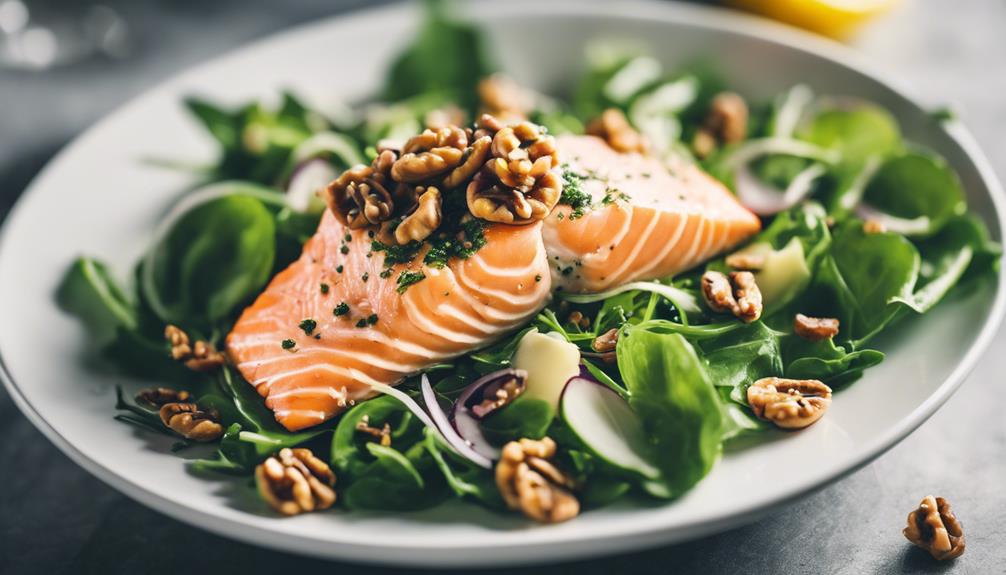
Curious about how different seasonings can enhance the flavor of your salmon dish? Experimenting with various seasonings can truly elevate your salmon into a culinary delight. Here are three popular salmon seasoning variations to contemplate:
- Lemon and Dill: The invigorating citrusy notes of lemon combined with the aromatic herbaceous flavor of dill create a light and zesty profile that pairs exceptionally well with the richness of salmon.
- Garlic and Herb Butter: Indulge in the decadent combination of garlic and herb-infused butter, adding a luxurious and savory dimension to your salmon. The buttery texture enhances the natural succulence of the fish, making each bite a delightful experience.
- Soy Ginger Glaze: For an Asian-inspired twist, try a soy ginger glaze on your salmon. The umami richness of soy sauce, coupled with the subtle heat of ginger, creates a harmonious blend of flavors that perfectly complement the salmon's taste.
Tasty Salmon Creations
When thinking about tasty salmon creations, consider trying out recipes like:
- Herb-Crusted Salmon Fillet
- Pistachio-Crusted Salmon Medallions
- Walnut-Crusted Salmon Medallions
These variations offer a crunchy texture and a burst of flavor that complement the natural richness of the salmon. Experimenting with different crusts can elevate your salmon dishes and add a creative touch to your meals.
Herb-Crusted Salmon Fillet Recipe
To create a delectable herb-crusted salmon fillet, infuse a perfect blend of herbs, breadcrumbs, and seasoning for a crispy and flavorful coating that elevates the taste of the salmon.
- Herb Selection: Choose a mix of fresh herbs like dill, parsley, and thyme for a fragrant and vibrant herb crust.
- Breadcrumbs Texture: Opt for panko breadcrumbs for a light and crunchy texture that complements the tender salmon.
- Seasoning Balance: Find the right balance of salt, pepper, and any additional seasonings like garlic powder or lemon zest to enhance the overall flavor profile of the dish.
This herb-crusted salmon fillet not only provides a crispy texture but also enhances the natural flavors of the salmon for a delightful dining experience.
Pistachio-Crusted Salmon Medallions
Indulge in the tantalizing blend of crunchy pistachio crust and succulent salmon medallions for a flavorful and nutritious dining experience. The pistachio-crusted salmon medallions offer a delightful contrast of textures, with the crispy exterior giving way to the tender, juicy salmon inside. This dish not only satisfies your taste buds but also provides a boost of healthy fats and essential nutrients. The pistachios bring a rich, nutty flavor to the salmon, elevating the overall taste profile of the meal. By combining the omega-3 fatty acids from the salmon with the protein, fiber, vitamin B6, and potassium from the pistachios, you're treating yourself to a wholesome and delicious culinary creation.
- The pistachio crust adds a crunchy texture and nutty flavor to the salmon.
- Pistachios are a good source of protein, fiber, vitamin B6, and potassium.
- The combination of pistachios and salmon creates a flavorful and satisfying meal.
Walnut-Crusted Salmon Medallions
Adding a delightful twist to your culinary repertoire, walnut-crusted salmon medallions offer a delectable and nutritious dining experience.
- The combination of fresh salmon and crunchy walnuts creates a harmonious blend of textures and flavors.
- Walnuts not only add a delicious nutty taste but also provide a rich source of omega-3 fatty acids, promoting heart health and overall well-being.
- By encrusting the salmon with walnuts, you elevate the dish to a gourmet level while keeping it simple and approachable for any home cook.
This innovative approach to preparing salmon showcases a perfect balance of elegance and wholesomeness, making it a standout choice for a memorable meal.
Salmon Searing Temperature Guide
When searing salmon, hitting the optimal temperature sweet spot, typically between 400-450°F, is essential for achieving that perfect texture and flavor. The high heat helps to produce a caramelized crust on the fish, sealing in juiciness and enhancing the overall eating experience.
Ensuring your pan is hot and oiled properly sets the stage for that crispy skin and succulent interior you desire in a well-seared salmon dish.
Searing Temperature Importance
The ideal searing temperature plays an essential role in enhancing the texture and flavor of salmon, ensuring a crispy exterior and juicy interior. When searing salmon, it's recommended to use medium heat, typically around 400-450°F. This temperature range allows the salmon to develop a beautiful golden crust while keeping the interior moist and tender.
Searing at too low of a temperature can lead to the fish steaming rather than achieving the desired caramelization. By maintaining the right searing temperature, you can guarantee that the salmon cooks evenly, locking in its natural juices for a succulent result.
Perfect Salmon Texture
Achieving the perfect texture for your salmon starts with maintaining the ideal searing temperature. When searing salmon, aim for a temperature range of around 120-130°F to guarantee a tender and moist result. Sous vide cooking is particularly advantageous for this, as it allows precise control over the cooking temperature, leading to consistently juicy salmon. Overcooking salmon can result in a dry and tough texture, emphasizing the importance of monitoring the searing temperature. Searing at too high a temperature can cause rapid protein contraction, leading to moisture loss and an undesirable texture. By gently searing at the right temperature, you can preserve the natural oils and flavors of the salmon, enhancing the overall dining experience.
| Temperature (°F) | Texture | Outcome |
|---|---|---|
| 120 | Tender and moist | Perfect texture |
| 130 | Slightly firmer | Still juicy and flavorful |
| >130 | Dry and tough | Overcooked, less desirable |
Achieving Crispy Skin
To achieve crispy skin on your salmon, make sure a hot skillet and essential seasoning are used to enhance the texture and flavor.
The ideal searing temperature for salmon skin hovers around 400°F, ensuring a perfect crisp without overcooking the fish. Preheating the skillet thoroughly is vital as it helps to crisp up the skin evenly while keeping the salmon moist.
Seasoning the skin side of the salmon with salt not only adds flavor but also aids in drawing out moisture, resulting in a delightfully crispy texture. Remember to avoid overcrowding the skillet; this allows for proper heat distribution, ensuring each fillet gets the perfect sear and crispy skin.
Final Thoughts
In reflecting on the melding of flavors and nutritional benefits in this dish, one can't overlook the harmonious balance achieved between the sous vide salmon, walnuts, and mixed greens.
The succulent sous vide salmon brings a rich source of omega-3 fatty acids, promoting heart and brain health while providing a tender and flavorful experience. Paired with the crunchy texture and nutty essence of walnuts, the mixed greens salad not only offers a delightful contrast but also a powerhouse of healthy fats, antioxidants, and essential nutrients.
The combination of these ingredients not only satisfies the palate but also nourishes the body, making it a well-rounded meal option. The precise cooking method of sous vide guarantees that the salmon retains its moisture and delicate taste, elevating the overall dining experience.
As you indulge in this dish, savor the intricate dance of flavors and textures that the salmon, walnuts, and mixed greens bring to the table, offering both culinary delight and nutritional value.
Frequently Asked Questions
How Long Does It Take to Sous Vide Salmon?
When sous viding salmon, it takes a cooking time of 20-45 minutes, depending on fillet thickness. The sous vide method guarantees precise temperature control, resulting in perfectly cooked salmon every time.
What Pairs Well With Salmon?
When pairing salmon, consider wines like Pinot Noir or Sauvignon Blanc for their versatile profiles. The flavors of lemon, dill, and garlic enhance the fish. Earthy herbs complement its richness. These combinations create a delightful dining experience.
Can You Freeze Sous Vide Salmon?
Yes, you can freeze sous vide salmon. Utilize proper freezing techniques by vacuum-sealing it before storage to maintain texture and flavor. Thaw frozen salmon in the refrigerator overnight. Consume within 2 days after thawing for best freshness.
How to Season Salmon?
When seasoning salmon, you enhance its natural flavors and create a delightful crust. Experiment with salt, pepper, herbs like dill, or spices like paprika for diverse flavor profiles. Utilize sous vide techniques or traditional cooking methods for best results.
Conclusion
Indulge in the delicate flavors of sous vide salmon paired with crisp mixed greens and crunchy walnuts.
The perfectly cooked salmon, seasoned to perfection, adds a burst of rich, buttery taste to every bite.
With the right searing temperature, you can achieve a golden crust on the outside while keeping the inside tender and moist.
This mixed greens salad with sous vide salmon and walnuts is a culinary delight that will leave your taste buds craving for more.
